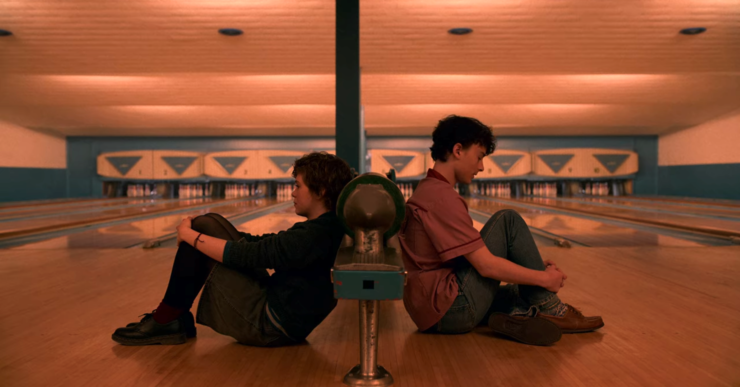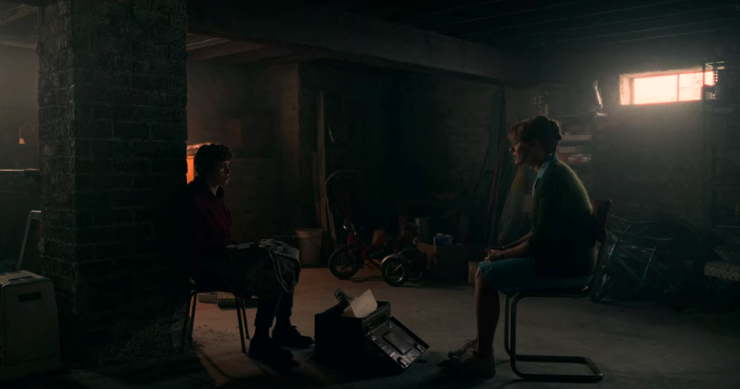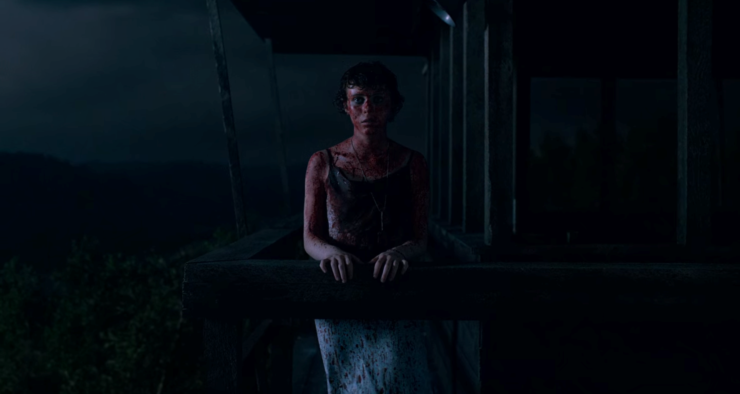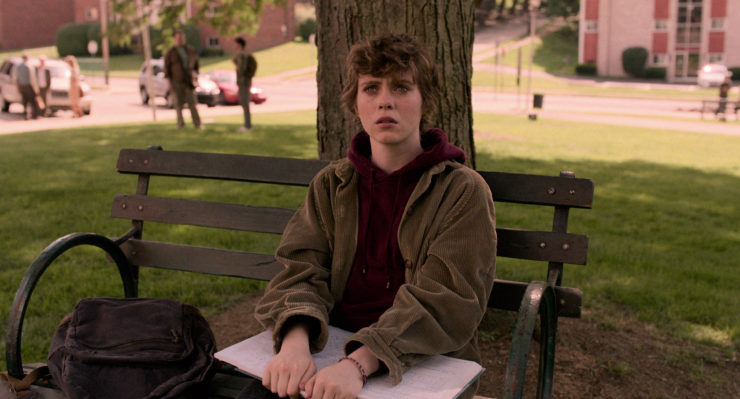The Netflix original series I Am Not Okay with This, directed by Jonathan Entwistle and based on Charles Forsman’s graphic novel of the same title, follows 17-year-old Sydney “Syd” Novak (played by Sophia Lillis) as she navigates the complexities of high school and teenage life while making sense of her growing telekinetic abilities. Since its premiere on February 26, the seven-episode series hit the Netflix top 10 list in the US and the UK and received praise for its take on the superhero origin story, its homage to 1980s pop culture and aesthetics, and its unflinching exploration of teen angst. Though a supernaturally-charged comedy-drama, Not Okay is also a tale of identity and family in the wake of a parent’s suicide and the destructiveness of unmitigated grief.
[Content warnings: suicide, violence, self-harm, grief, PTSD]
The first episode begins in media res, with a long shot of Syd running down the street towards the camera/viewer. It is nighttime, and her dress and face are splattered with what appears to be blood. She pauses, and the camera cuts to a medium shot, then a closeup, of the dog tag around her neck. From the outset, this shot sequence establishes a connection between the violence of the scene Syd is fleeing and the dog tag she’s wearing (and by extension, her deceased father, to whom it once belonged).
The episode then jumps back in time to the immediate past to formally introduce Syd. Via interior monologue, she tells us (and her diary) that she’s a “boring seventeen-year-old white girl” who isn’t anything “special.” She’s in the office of the school guidance counselor, who gives her a journal to help with her moods. Apparently, Syd has anger issues, as can be seen in the brief montage of her breaking a pencil in half, kicking down a trash bin, and snipping at her hair in the middle of class. The journal is supposed to act as a container, allowing her to externalize feelings non-destructively. But the feelings of anger and confusion that a parent’s death to suicide leaves in its wake can’t be easily or safely contained, as the rest of the series powerfully illustrates.
It’s clear from Syd’s thoughts that she misses her father dearly. Though she doesn’t express anger at his abandonment at the outset, her short fuse when disappointed by the people she trusts suggests displaced anger, and it’s during these moments that her powers manifest. Syd and her best friend Dina (Sofia Bryant) moved to the (fictional) rust belt town of Brownsville, Pennsylvania around the same time, and they immediately bonded. But the girl who comforted Syd when she received news of her father’s death is now spending more time with a mean-spirited boy Syd dislikes, doing uncharacteristic things like going to football games and pep rallies. When Dina, to whom she is secretly attracted, passes her over for “meathead” jock Bradley Lewis (Richard Ellis), Syd uses her power to give Bradley a nosebleed.
The impact of a parent’s suicide on surviving children can be mitigated by a solid support network that provides a safe holding space in which taboo feelings can be aired. Without such a space and empathetic ears, the negative feelings fester. In the Novak family, suicide is “that heavy thing we’re all too afraid to talk about.” Syd and her mother Maggie (Kathleen Rose Perkins) have not spoken about her dad since he hanged himself. Maggie has buried herself in her work at the diner, working sixty hours per week covering multiple shifts – to make ends meet for the financially strapped family, and arguably, to avoid having to sit with her pain. Consequently, Syd is left with caring for her mature younger brother Liam (Aidan Wojtak-Hissong), a responsibility she resents despite her deep love for him.
Unsurprisingly, Maggie is often too exhausted and emotionally unavailable to her children. When Syd tells her, “Sometimes, it feels like the people I love don’t love me back,” she coldly replies: “Well, maybe you’re just aiming too high, hun.” Disappointed once again by a person she trusts, Syd flees to her room in anger, and with her mind she causes the wall behind her to crack. Her thought sequence prior to the outburst is telling: “Dad would have understood, but he hung himself,” followed by, “I feel like I’m boiling inside.” She is angry at the void he left behind and at others’ inability to fill that void. Syd covers up the cracked wall with a dresser. However, the system of avoidance and denial at work in many families of suicide, meant to protect individual members’ feelings in the short run, can only exacerbate the bereavement process and lead to complicated grief. Cracks soon become fissures when left unattended.
When a beloved parent dies by suicide, surviving children are left with a mystery that incites endless questioning and re-evaluations of the self. They may question their deceased parent’s love for them and come to the conclusion that they’re unlovable and abnormal, for the parent would have remained otherwise. Syd is confronted with such questions when she goes down to the basement, the site of her father’s death, to retrieve a puzzle for Liam. Solving puzzles every Sunday morning was dad and Liam’s thing, Syd tells us, a ritual Liam seems to want to pick back up. Her anger mounts when she realizes how little she understood her father, who didn’t leave a suicide note. “I mean, did he really have no idea I was gonna be such a freak?” she asks herself and her viewers. “I mean, did he think I wouldn’t need him around? I mean, why would he do that?” Syd’s seething anger causes objects to rattle in the basement, and upstairs, it kills Banana Wigglesworth, Liam’s pet hedgehog.
Liam asks Syd to deliver the eulogy at Banana’s makeshift funeral, which she addresses to her father, with Paul Young’s “Everytime You Go Away” aptly playing in the background. “I wish I was there for you at the end. Had we known that you needed help, we would have given it to you,” Syd begins plaintively. “This just isn’t fair. You’re gone now and there’s nothing we can do about it. We both miss you so much. Everything is different without you around.” Syd’s eulogy poignantly illustrates the multi-dimensionality of grief. Grief is a complex of feelings, including but not limited to anger. Back in her bedroom, Syd worriedly asks herself, “Oh god, when does this get easier,” at which point, objects begin to levitate. It’s now clear – to Syd and to us viewers – that her powers are not only connected to anger over her father’s suicide, but to grief over her loss and uncertainty over the future.
A crucial element of suicide bereavement and recovery is the reconstitution of sustaining ties to others, transforming the feeling of singularity to that of communality. For Syd, one such other is Stanley Barber (Wyatt Oleff), her classmate, neighbor, and a “master of zero fucks.” Although Syd doesn’t reciprocate Stan’s romantic feelings, she feels “a little less weird” with him. More importantly, he’s the first person to learn of her powers. After seeing her fell trees with a telekinetic force blast (she’d just kissed Dina and didn’t get the reaction she was hoping for), he promises to keep her secret safe. When Syd accidentally unleashes her power in the school library, for example, he organizes a heist to break into the principal’s office and retrieve the captured footage. Stan also offers to be Syd’s mentor. After all, he explains, every superhero has a mentor figure in their life who helps them learn to control their powers. He “trains” Syd to perform a number of telekinetic feats at the bowling alley where he works – from making popcorn kernels pop to knocking down stacks of beer cans and bowling pins. Though his coaching efforts prove to be unsuccessful, and though she’s often rude to him, his character relieves Syd of the unreasonable pressure to be “normal.”

A parent’s suicide can lead to distorted communication in the family and exacerbate existing conflicts between members. This is especially the case with Syd and her mother; as Liam astutely observes, “It’s like you and mom try to find reasons to be mad at each other.” In one heated exchange, Maggie says she’s coming home late and asks Syd to make Liam dinner. “I’m practically his mom,” Syd mutters under her breath. Maggie confronts Syd, who then complains that her father wouldn’t ask her to do so much if he were still around. A deeply hurt Maggie rebukes Syd for her unfair preference: “You always choose him over me. And now he’s been gone for almost a year and you’re still choosing him.” Syd preferred her father to her mother in life, and his death drives the existing wedge between mother and daughter further.
But in order for familial conflicts to be resolved, survivors must communicate openly about the suicide itself. The above exchange, though fraught with emotion, paves the path for mending the mother-daughter rift. Thus, it is especially fitting that Syd’s under-appreciated mother is the one who gives Syd the answers to her questions in the series’ penultimate episode.
Syd tells her guidance counselor that she has a foreboding sense of being followed, and the counselor suggests that Syd is having grief hallucinations of her father. Seeking some kind of closure, Syd descends into the basement once more and rifles through her father’s belongings. Under his work desk, she stumbles upon a locked box. For the first time in the entire series, Syd channels her power constructively, using her mind to unlock the box. Her power, it would appear, is key to unlocking the mystery of her father’s suicide. The contents of the box are revealed to be objects from his time in military service, including his uniform, medal, and dog tag. It is at this moment that Maggie arrives and provides Syd with much needed context.

Syd’s father enlisted in the military shortly after he got married. During his last tour, an explosion killed everyone on both sides of the conflict, including civilians. He was the only one to survive. Like father, like daughter, Syd realizes she inherited her powers from him. It’s unclear whether his powers caused the explosion or protected him from the blast (or both), but it’s apparent that he suffered from post-traumatic stress and survivor guilt. Like Syd, he became paranoid that he was being followed and fled from situations that produced intolerable stress. Throughout the scene, the camera cuts back and forth between past and present, underscoring the parallelism and intergenerational transmission of trauma between father and daughter. War trauma lit the fuse of her father’s abilities, eventuating in his demise. The trauma of his suicide, in turn, catalyzed Syd’s supernatural awakening.
“He had something in him,” Maggie continues, “something that he was always wrestling with. And that thing won.” Maggie pleads with Syd to talk to her if Syd ever experiences the same turbulent feelings her father did. Both women are on the verge of tears, and for once they are able to empathize with each other over their shared grief.
Survivors of suicide can never truly know with absolute certainty why a loved one chooses to end their life. Precipitants can be located in the immediate present, but they can also be rooted in the distant past. Moreover, suicide is multiplex, irreducible to a singular cause. What is important isn’t arriving at a definitive answer to the mystery of suicide (there isn’t one), but being able to narrativize the loss, make sense of what was previously senseless, and have one’s pain empathically received and understood by others. Though the pain of a family member’s suicide lasts a lifetime, one can experience post-traumatic growth and find meaning in the face loss. Syd finds her answers, and she’s now ready to resume the life she has nearly lost control of.
At the beginning of the seventh and final episode, Syd asks herself if she would allow her power (i.e. her trauma) to destroy her, or refuse to let it weigh her down. She opts for the latter – “The less of a fuck I give, the less likely I am to break shit” – and her newfound positivity colors much of the episode. She makes Liam pancakes for breakfast and decides to go to homecoming with Dina, who’s no longer with Brad after Syd revealed his infidelity in a previous episode. Later in the evening, Syd shares a tender moment with her mother, who helps her zip up her dress. Maggie tells Syd that she shared her first kiss with Syd’s father at a school dance. That they can now share joyful memories of him attests to the emancipatory power of narrativizing the suicide.
Syd wears the dog tag she found in her father’s safe box. The dog tag serves as a linking object, a personally significant item that allows the living to feel connected to the dead. For Syd, it symbolizes her and her father’s shared history and trauma, and thus, her identification with him. In yet another clever parallelism, Liam is shown solving a puzzle – his linking object – when Syd comes down to the living room to meet Dina. Wearing an oversized robe that can only belong to his father, Liam plays the role of dad and tells Syd to come home by 8 pm, and above all, to have fun. In short, rather than sever ties with the deceased, both children take the healthier route of incorporating into themselves key attributes of their beloved parent.
The evening is full of promise as Syd renews her friendship with Stan, and as Syd and Dina take to the dance floor. They revisit the subject of the kiss they shared, and Dina confesses that she didn’t not like it, making Syd blush. It is therefore tragic (yet expected by us viewers) that Brad, as payback for Syd’s previous offense, undercuts Syd’s progress in her road to recovery. Brad had gotten hold of her journal and makes its inviolable contents public at homecoming – from her “pathetic” attraction to Dina to her sensitive “daddy issues.” Just before he reveals that Syd has superpowers, his head explodes in a gruesome fountain of blood, causing everyone on the dance floor, including Syd, to flee in shock and abject terror. The series has come full circle, and it’s now clear why Syd’s clothes were drenched in blood in the first shot of the first episode.

In the original source material, a remorseful Syd kills herself by blowing up her own head. The graphic novel fulfills the grim forecast that a parent’s suicide confers upon surviving children a fifty percent chance that they would one day attempt or succumb to suicide. In the televisual adaptation, however, Syd retreats to a fire watch tower and considers running away. The mysterious figure that has been stalking her, one capable of disappearing into smoke, finally appears. When Syd asks, “Should I be afraid,” he responds, “They should be afraid. Let’s begin.”
Whereas the graphic novel tells a complete yet fatalistic story of grief and suicide, the Netflix adaptation leaves open the possibility of a continuation. But the message of the first season is clear: bereavement and recovery from a parent’s suicide is a delicate process that is contingent upon the larger social fabric and its myriad actors, from empathetic listeners to agents of retraumatization. I Am Not Okay with This doesn’t shy away from depicting suicide’s impact on children and families, and it does so with sensitivity, showing viewers how people can process trauma in real life and feel more in control, while alerting them to the roadblocks ahead. Syd’s wound has been forcefully reopened just as it was beginning to heal, casting uncertainty over her future once more.
Dr. Alvarez studies end-of-life communication in interpersonal and mediated contexts and suicidal individuals’ use of digital technologies to co-create meaning and community. He is the author of the forthcoming book, The Paradox of Suicide and Creativity (Rowman & Littlefield), and he has completed a memoir of his past struggle with suicidal depression titled, The Color of Dusk. Visit his website and follow him on Twitter @mfalvarez121.










